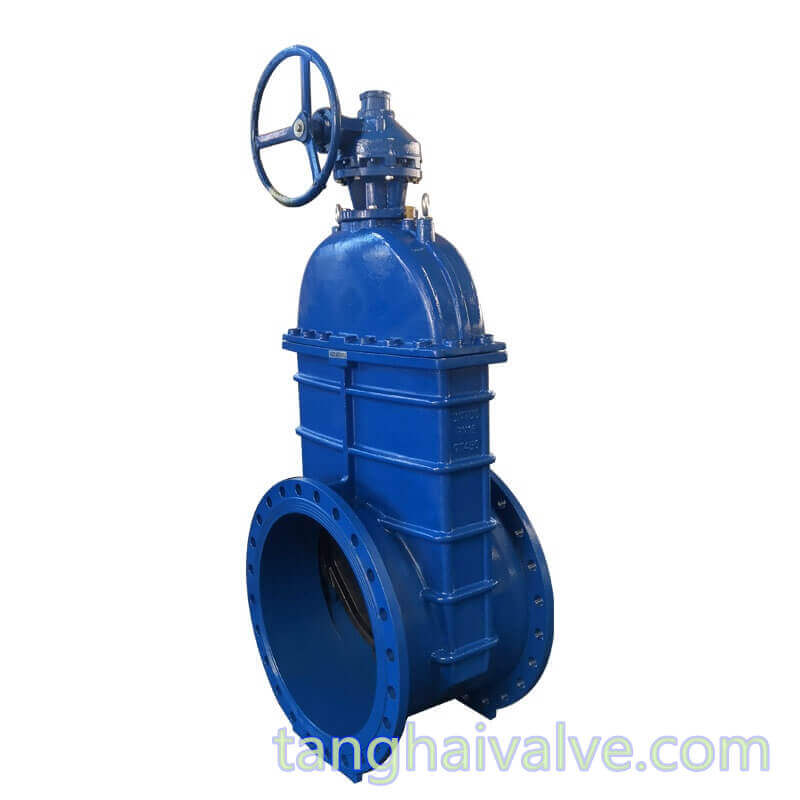Form and types of Gear transmission
Gear transmission types:
As per the mutual position of the two wheel axes, gear transmission can be divided into plane gear transmission and space gear transmission.
According to the type of gear transmission:

BS5163-BB-NRS-soft seated-wedge gate valve-DN700-PN16-bevel gear (8)
1. According to the relative position of the two shafts and the direction of the gear teeth, it can be divided into the following types:
<1>Cylinder gear drive;
<2>Bevel gear transmission;
<3> Cross-axis helical gear transmission.
2. According to the working conditions of the gear, it can be divided into:
<1> Open gear transmission, the gears are exposed, and good lubrication cannot be guaranteed;
<2>Half-open gear transmission, the gear is immersed in the oil pool, with a protective cover, but not closed;
<3> Closed gear transmission, gears, shafts and bearings are all installed in a closed box, with good lubrication conditions, difficult to enter dust, accurate installation, gear transmission with good working conditions, and it is the most widely used gear transmission.
3. According to the hardness of the tooth surface:
<1>Soft tooth surface gear The hardness of the tooth working surface is less than or equal to 350HBS or 38HRC;
<2>Hard tooth surface gear The hardness of the tooth working surface is greater than 350HBS or 38HRC. When a pair of gears are driven.
The form of gear transmission:
1. Parallel shaft gear (cylindrical gear)
(1) Spur gear: A straight cylindrical gear with tooth ribs parallel to the axis.
(2) Rack (Rack): A linear gear that meshes with a spur gear. It can be said to be a special situation when the pitch of the gear becomes infinite.
(3) Internal gear: The inner gear of a straight cylinder that meshes with the spur gear.
(4) Helical gear: Cylindrical gears with helicoid teeth.
(5) Helical rack: a linear gear that meshes with a helical gear.
(6) Double helical gear: a helical gear formed by left and right spiral tooth ribs.
2. Right-angle shaft gear (bevel gear)
(1) Straight bevel gear: A bevel gear whose tooth ribs are consistent with the generatrix (straight line) of the pitch cone.
(2) Spiral bevel gear: A bevel gear with a bevel line with a spiral angle.
(3) Zero helical bevel gear (Zerol bevel gear): a bevel gear with zero helix angle.
3. Gears with staggered shafts (worm gear and worm)
(1) Cylindrical worm gear: Cylindrical worm gear is the general name of worm (Worm) and gear (Wheel).
(2) Staggered helical gear (screw gear): This is a cylindrical helical gear, which is called when it is used for transmission between staggered shafts (also known as skew shafts).
(3) Other special gears: Face gear: a disc-shaped face gear that can mesh with a spur gear or a helical gear. Concave worm gear: Concave worm gear and its meshing gear. Hypoid gear: Conical gear that conveys the wrong axis. The shape is similar to a curved bevel gear.
TH Valve is a professional manufacturer of butterfly valve, gate valve, check valve, globe valve, knife gate valve, ball valve with API, JIS, DIN standard, used in Oil, Gas, Marine industry, Water supply and drainage, fire fighting, shipbuilding, water treatment and other systems, with Nominal Diameter of DN50 to DN1200, NBR/EPDM/VITON, Certificates & Approvals: DNV-GL, Lloyds, DNV, BV, API, ABS, CCS. Standards: EN 593, API609, API6D
Related news/knowledge:
What is the positive transmission of gears
Types of mechanical transmission
Stainless steel valve material parameters and specific applications



 © Copyright 2020 Tianjin Tanghaidongyang Valve Co., Ltd. All Rights Reserved.
© Copyright 2020 Tianjin Tanghaidongyang Valve Co., Ltd. All Rights Reserved.